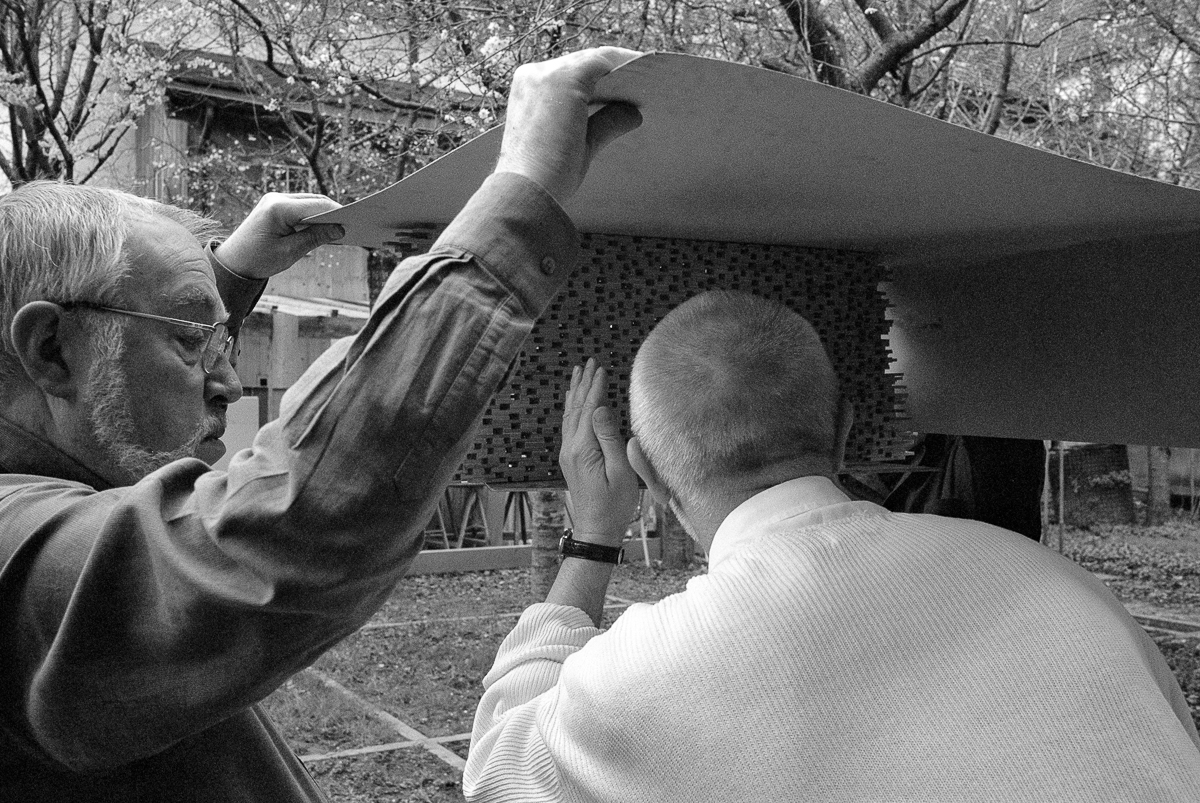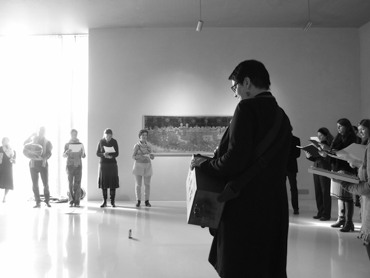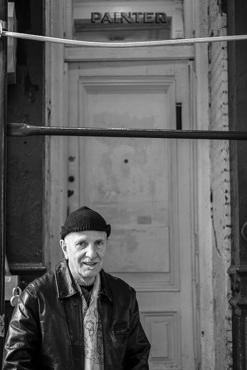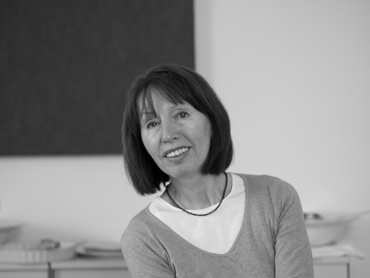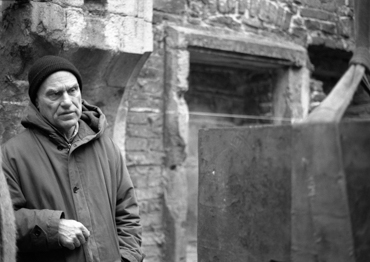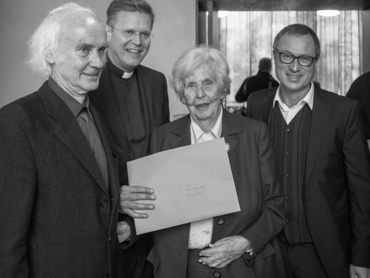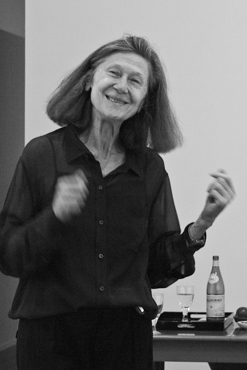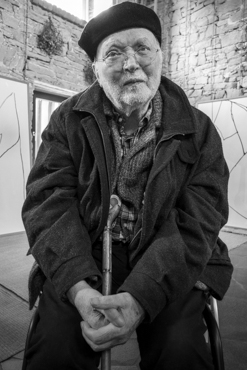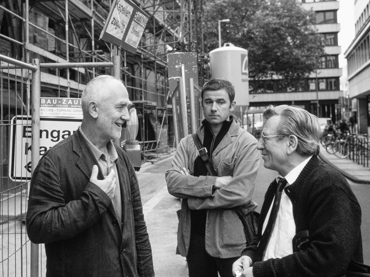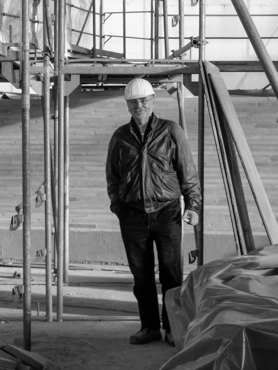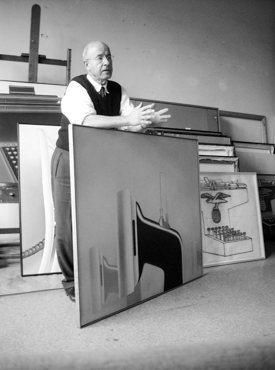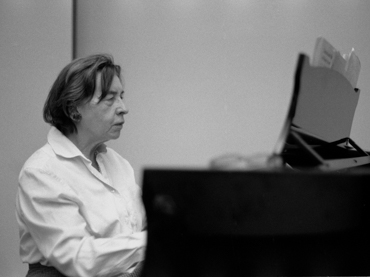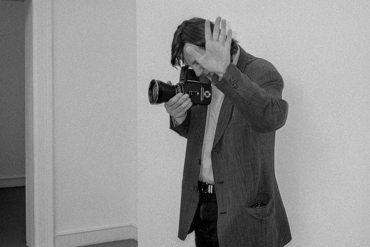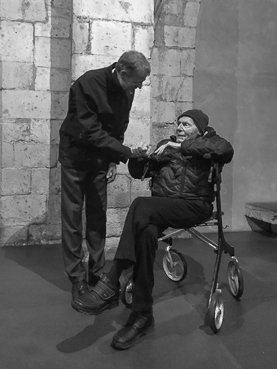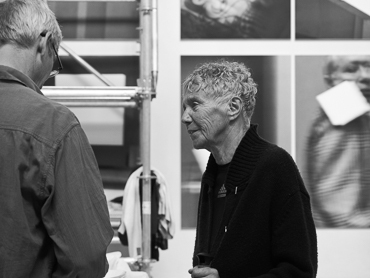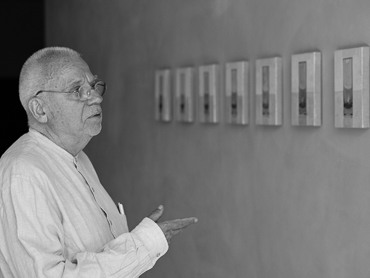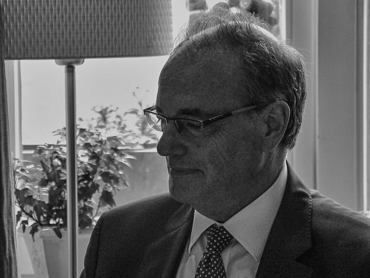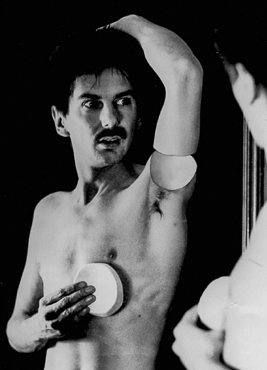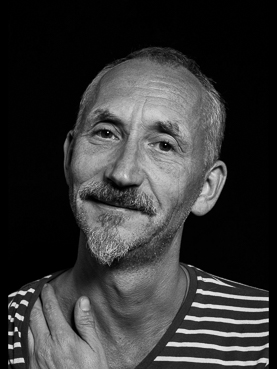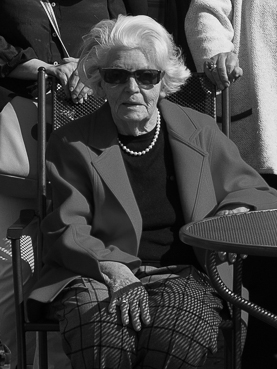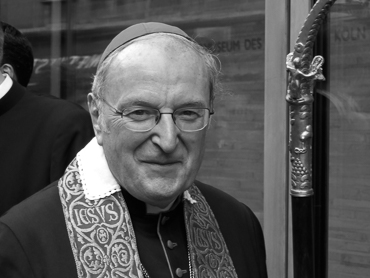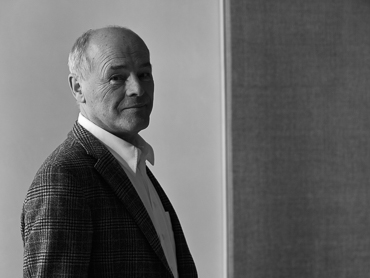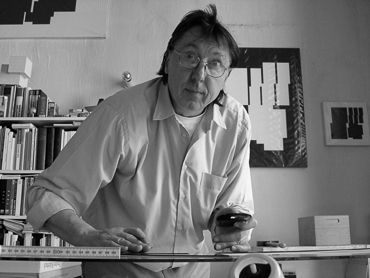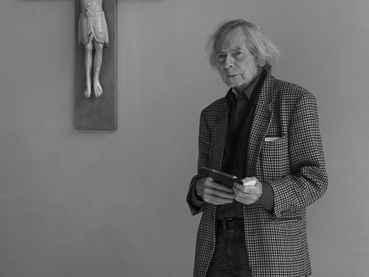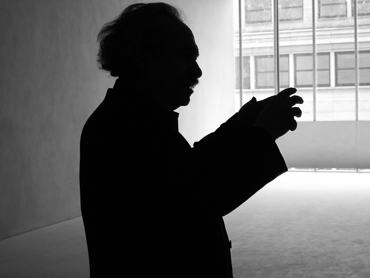We mourn the loss of ...
Josef Rüenauver (1936 - 2025)
Just as every major project needs a window of time within which it can be realized, it also needs people to help push it through. One of them was Josef Rüenauver. As the archdiocesan master builder, the qualified architect was both a qualified and assertive client representative and our guarantor for cultural issues within the archdiocesan administration. Having succeeded in convincing him of the open concept of a “Museum of Thoughtfulness” (Joachim M. Plotzek), he resolutely supported the realization of the new building project until May 2001, when he retired. It was probably also due to the experience he had gained during his time in Paderborn with the construction of the diocesan museum there (architect Gottfried Böhm) that he was able to get enthusiastic about the idea of an art museum sponsored by the church. He was convinced that the church had to be exemplary and contemporary, especially in terms of building culture. “Jupp” Rüenauver was a true Westphalian, his words were calm and deliberate, his attitude reliable and interested in continuity. His conversation was interspersed with lightning-fast, slightly mocking humor, which was never hurtful but usually relaxing. In the Kolumba planning team, the pipe-smoking master builder, who loved to drink good red wine, was an ideal conversation partner. He took part in Kolumba's social life until the very end and was delighted to have an open house, the realization of which he helped make possible. He died in Paderborn on May 31 at the age of 89.
Ludwig Schöller (1928 – 2025)
Ludwig Schöller, born in 1928, passed away on March 21, 2025 at the ripe old age of 97. He was a sensitive and empathetic prelate and former cathedral chaplain who was ordained a priest in 1956 and immediately afterwards was appointed secret secretary to Cardinal Josef Frings. Throughout his life, Ludwig Schöller was a contemporary inspired by literature, the visual arts and music, who preferred to spend his vacations in museums. Sometimes doubtful about what characterized contemporary art, he nevertheless observed with pleasure how the collection expanded through targeted acquisitions and donations. He had every confidence in our work and was a regular visitor to our exhibitions until the end.
Elmar Buck (1945 – 2024)
As head of the Institute for Theater, Film and Television Studies at the University of Cologne from 1979 to 2010, the Germanist and theater scholar Elmar Buck was also head of the associated theater studies collection at Schloss Wahn. He had a collegial relationship with Kolumba, which manifested itself in the handling of the Eva Weininger donation in 1998. At the widow's request, he gave us works of Andor Weininger, which had been on permanent loan to the Theatermuseum, and in return received all the designs for his vision of the Spherical Theater as a gift. Elmar Buck accompanied Kolumba with great sympathy. He died in Cologne shortly before the end of the year at the age of 79.
Maria Jonas (1957 – 2024)
With the death of Maria Jonas, who died in Brühl shortly before Christmas the music city of Cologne has lost one of its most creative personalities. After studying oboe, Maria went to South America and ran a music school in Venezuela for several years. Back in Europe, she devoted herself to her vocal training with Jessica Cash in London and to studying early music with Monserrat Figueras in Barcelona and René Jacobs at the Schola Cantorum Basiliensis. She has taught historical singing at the Musikhochschule Leipzig and Gregorian chant at the Musikhochschule in Cologne. Maria was a singer, lecturer and, above all, a researcher into the performance practice of medieval music. With her ensemble Ars Choralis Köln, she provided significant impetus for the rediscovery of music from women's monasteries, above all that of Hildegard von Bingen. Kolumba was her ideal sound space. Together with her, we established the concept of the sound workshop, to which she has invited international guests every first Sunday in November since 2008, alternating between work and performance situations during the opening hours - an annual highlight. The openness with which she explored and performed the spirituality of other religions remains exemplary for us.
Rebecca Horn (1944 – 2024)
The technoid character and sophisticated construction of her reliably working “Mechanized Sculptures” stands in tense contrast to their enigmatic function, to the vulnerability and delicacy of their message. Rebecca Horn belonged to the generation of artists who confronted the repression of historical responsibility in post-war German society with subversive criticism and the cautionary intrinsic value of poetry. Even their early performances dealt with the possibility of expanded self-knowledge and questioned the freedom of the individual and their relationship to the group. With the Blindenstab and the sculpture Berlin Earthbound, created for her solo exhibition at the Nationalgalerie Berlin, she enabled Kolumba to purchase two of her most important works in 1995, which became one of the milestones for the realization of the “Museum of Thoughtfulness”. On September 6, the internationally most renowned German artist died at the age of 80 in Bad König; home of her Moontower Foundation, which gives her work a permanent presence.
Joseph Marioni (1943 – 2024)
On September 6, the American painter Joseph Marioni died unexpectedly at the age of 81 in his adopted home of New York. As the son of Italian immigrants, Marioni was well acquainted with the history of European painting. He saw his lifelong struggle for a painting as a body of color, as a color of light, as a continuation of this tradition. In 1995, his Yellow Painting 1.1982, which we acquired from a private collection, became a groundbreaking juxtaposition for the museum concept with the sculpture of the standing Ecce homo from around 1500. Marioni found himself in this cross-temporal and cross-media juxtaposition in a way that he had never experienced before. This led to an ongoing dialog, which we will miss just as much as his hospitality, generosity and warmth of heart. Important milestones in our relationship were the solo exhibition Joseph Marioni - Triptych, which we showed in 1999 immediately after Andy Warhol – Crosses at the old location, the opening exhibition in the new building and the annual exhibition Noli me tangere, within which his works formed a common thread.
Barbara Wontorra (1949 – 2024)
Barbara Wontorra started as an administrative assistant in 1992 and from 1999 managed the secretariat of the Diocesan-Museum during the busy phase of completing the new building. With her life-oriented mentality and always looking on the bright side, she managed to keep her feet on the ground even in hectic phases and to deal with any excitement with balance and friendliness. She was part of the small museum team that met the daily challenges of the diverse tasks and the changing adversities of their realization with wisdom and humour. After her retirement in 2007, she remained responsible for the archive of the Renate König Foundation for a while. She died at the age of 74 on July 23 in her home town of Olpe after a long illness.
Richard Serra (1938 – 2024)
With the installation of his sculpture "The Drowned and the Saved" on February 24, 1997, the Kolumba project took shape for the first time. It was - parallel to the architectural competition - the conceptual laying of the foundation stone for the new building, which was accompanied by the great American sculptor in a quiet but highly concentrated manner. This was preceded by several years of deliberation as to whether the sculpture, created for an exhibition in the former village synagogue of Stommeln, should have a permanent presence in the ruinous sacristy of the former church. Serra, who had previously ruled out any change of location for his works, found it meaningful in this case, as the title refers to a book by Primo Levi and thus to his experiences in German concentration camps. Compared to other works by Serra, the two steel angles holding each other up form a less spectacular cabinet piece. But above the Romanesque cellar with the bones recovered from all the church's crypts, they link the memory of the past with our responsibility for the present. "You don't have to know anything about art, to understand this," Serra said at the time. He died in New York on March 26 at the age of 85.
Renate König (1928 – 2024)
It is with great gratitude that we mourn
the loss of Renate König. With her, we have lost our most important
patron and a friend who was as critical as she was generous. For over
thirty years, the economist, who was born in Duisburg in 1928 and
graduated from the University of Bonn, supported us privately and with
her foundation for the Promotion and Communication of Christian Art, which she
established in 1999. Almost all major acquisitions of so-called ancient
art, all extensive restoration projects and many of our publications would not have been possible without her support.
Particularly noteworthy are the domestic altarpiece by Konrad Zaunhack,
the alabaster relief "Adam and Eve hide from God", the painting of the
"Holy Lance", the two Gothic reliquary crosses, the "St. John's Bowl"
and the "Christ at Rest". In the modern era, we were able to acquire a
crucifixion scene by Louis Soutter and the early hand cross by Joseph
Beuys thanks to her support. In 2017, she deliberately donated her
collection of medieval manuscripts, one of the best in the world, which
she had been building up since 1981 with the academic support of Joachim
Plotzek. We owe the splendor of the
collection to her unconditional and continuous support. The fact that
our exhibitions draw (almost) exclusively on their potential without
loans was just as important to her as the communication of Christian
content and values in word and writing. The cooperation with Renate
König was based on trust and geared towards sustainability. Her high
standards of academic diligence and the aesthetic quality of her
presentations and publications were and remain our motivation. She lived
her patronage on the basis of her firm faith, modest and humorous,
unpretentious and strong-willed. The archdiocese owes her a great deal.
Cardinal Meisner awarded her the Maternus Plaque of the Archdiocese of
Cologne and presented her with the Papal Order of St. Gregory in 2009.
Renate König believed in the future of the church and helped to shape it
through her friendship with Kolumba. She passed away peacefully on
January 19 at the age of 95.
Margarete Roeder (1939 – 2023)
She was not just any gallery owner, she was unmistakable and just as unique as her biography. Born in Neunkirchen/Austria in 1939, she had lost both parents as a child, experienced National Socialism and the war in Vienna; presumably reasons for emigrating to Canada when she was not even twenty, where she worked in urban planning in Edmonton after completing her studies. In the early 1970s, she moved to Cincinnati to work for the art dealer Carl Solway, whose New York branch she took over. Around 1980, she managed the New York branch of the prestigious Crown Point Press, living and working with John Cage and Merce Cunnigham; a friendship that changed her life and led to the founding of her own gallery in 1986. Her participation in Art Cologne secured the fair one of its best stands for years, as Margarete Roeder was closely connected to her artists and had an unerring eye for quality. With the works of John Cage, among others, we owe her one of the identifying focal points of our collection. She passed away in Cologne on December 11 after a long illness.
Herbert Falken (1932 – 2023)
Until we met Herbert Falken in 1993, he had ruled out giving his works to a church museum. The reception of the painter and draughtsman, who was born in Aachen in 1932, was too focused on his second vocation, the priesthood, rather than on his art. Influenced by the Second Vatican Council as a young clergyman, Falken was a radical innovator who found a like-minded person in Heinrich Böll, his neighbor in Langenbroich. His work is an attempt to find a language to express what the clergyman, who was ordained in 1964, lacked the words for. Accompanied by doubts that drove him, drawing was his way of thinking and believing. Falken explored the labyrinth of his contradictions and used art to treat his existential fears. Head births, trauma, fear and longing for death were the themes that dominated him. Through Studies on Michelangelo, he found a freedom in the expression of the line that is unparalleled. In meditative contemplation ("someone else did it") and in serial variation, his work is a unique search for an expression of religious experience in exploring his relationship to God. In 1998, he received an honorary doctorate from the Faculty of Catholic Theology at the University of Bonn. With the series of Krankenbilder, diary-like sheets from the 1970s, the Gitterköpfe, all the artist's books and the magnificent drawings from his late work, Kolumba owns the legacy of this credible artist. He died in Düren on October 31, 2023.
Father Gabriel Weiler OMF (1937 – 2023)
Those who knew him will remember above all his calm voice, which always radiated a thoughtful serenity. Gabriel Weiler, born in Ludwigshafen-Oggersheim in 1937, followed his vocation as a religious and priest after training as a chemical laboratory technician. He joined the Franciscan Friars Minor in 1963, made his first profession in 1964 and was ordained a priest in 1967. As Guardian of the monastery and Rector Ecclesiae, he was responsible for St. Kolumba for over 30 years and was known throughout the district as Father Gabriel, a pastor and confessor. He was intensively involved with the history of St. Kolumba and was therefore open to the new building project with the enclosure of the chapel. During the realization phase, he was a reliable partner who knew how to bring in the spiritual/liturgical concerns and defend the project against the numerous critics in the parish. Most recently, he was delighted that the dark Holy Spirit window by Jan Thorn-Prikker was given an illumination that was barely noticeable from the outside. He died on October 8, 2023, after a heart attack that was recognized too late.
Heinz-Jürgen Rothkegel (1945 – 2023)
As an employee of the Cologne architectural firm Stein Architekten, which was commissioned with the construction management, Heinz-Jürgen Rothkegel was a reliable anchor point during the multi-year construction phase of Kolumba (2002 – 2007). With his many years of experience, he accompanied the realization of the building together with the project manager from Zumthor's office, often with complicated details that were precisely discussed with all those involved before they were implemented. Even in critical situations, he maintained an overview and calm and supervised the adherence to and updating of the construction schedule, which depended on many factors. Due to his level-headed charisma and pragmatic approach, he was highly respected by the tradesmen working on the project. He died in Cologne on August 4, 2023 at the age of 77.
Konrad Klapheck (1935 – 2023)
The Düsseldorf painter Konrad Klapheck died on July 30 at the age of 88. He was the only child of the art historian Richard Klapheck, who died young, and his wife, the art critic Anna Klapheck. He made his mark on art history with paintings that elevate technical devices to the status of pictorial objects. “With the help of the machine, I was able to draw things out of myself that were previously unknown to me; it forced me to reveal my most secret wishes and thoughts”. A relationship to late Gothic painting is just as important to him as it was to the pittura metafisica and magical realism of the 1920s. His involvement with the Surrealists, who cultivated their relationships with the Artist-Group Das Junge Rheinland through Max Ernst, a group that included Walter Ophey and Klapheck's teacher Bruno Goller, two painters whose machine paintings and worlds of things attracted him from a young age, was also important to him. For Kolumba in 2004, he parted with two of his paintings that had been exhibited many times but had until then been well protected in his studio: The Will to Power (1959) and The Mothers (1960). His trust in our work and the stimulating studio visits remain in grateful memory.
Tiny Wirtz (1923 – 2023)
Hans Anwander, who was her teacher at the Cologne Academy of Music from April 1946, had been teaching her since she was seven years old. Her great talent, her perseverance and her early emancipated self-confidence led to a unique career. Her concerts with the Gürzenich Orchestra under the direction of Günter Wand in the winter of 1945/46 in the overcrowded auditorium of Cologne University, with no windows and no heating, became legendary. As the youngest member of the Donnerstagsgesellschaft (Thursday-Society) Tiny Wirtz was at the center of an intellectual renewal of cultural life in the Rhineland. She became a leading interpreter of contemporary music, played the world premieres of all of Bernd Alois Zimmermann's piano works and later worked with composers who had been significantly influenced by jazz, among others. From 1963 to 1994, she taught at the Cologne Academy of Music and gave concerts and master classes all over the world. At home, she was surrounded by works by artists with whom she had a lifelong friendship, especially Hubert Berke. In 2009, she decided to donate her collection to Kolumba because the natural connection between past and present corresponded to her own feelings. A few weeks after her 99th birthday, the Cologne pianist passed away on January 9, 2023.
Lothar Schnepf (1952 – 2022)
Lothar Schnepf was a point of reference in the Cologne art scene, of which he had been a member since the early 1970s. In over four decades, he worked for so many artists, galleries and exhibition venues and did not focus on the big names for whom he could have worked exclusively. The fact that he was the best when it came to photographing art in space is proven by countless books that could not have been published without his outstanding work. Since 1996, he has produced all the work and exhibition photos for Kolumba. Because he denied being an artist himself, he was able to realize his artistic work – disguised as a commission. Under the pseudonym he chose, Lukas Rohrbach, we were able to publish his fourteen photographs of James Lee Byars' last performance 666 in 1999. The analog color photographs in the book on the collection of works and forms published in 2006 are examples of his mastery. Lothar Schnepf was a very well-read, sensitive and refined person whose incorruptible attitude could be uncomfortable, but was always thoroughly honest. He passed away on November 5, 2022 after a short, serious illness at the age of just seventy. We miss his passion, his humor and his unique perspective.
Gottfried Böhm (1920 - 2021)
He was not completely reconciled with Kolumba until the end. Gottfried Böhm felt his own responsibility for the site. For the son of the great church architect, the chapel consecrated in 1950 was the first independent building, which he was able to extend in 1956 with the dark Sacrament Chapel. Both buildings demonstrate his architectural skills in all their details: the improvised use of historical fragments, the bold positioning of the new structure, the lightness of the concrete fabric ceiling and, last but not least, the sculptural quality of the interior details. Böhm has worked on designs for the development of the site three times, most recently in 1996 in the competition for the construction of the museum. He also planned the enclosure of the chapel, as realized by Peter Zumthor, who won the competition, with a protective vestibule. The encounter between the two Pritzker Prize winners (Böhm 1986/ Zumthor 2009), whose architectural language has parallels, was as respectful as it was exciting. Gottfried Böhm celebrated his 100th birthday with a thanksgiving service in the chapel. He died in Cologne on June 9, 2021. Kolumba also remains his legacy.
Anna Blume (1936 – 2020)
The delicacy of Anna Blume’s pencil drawings and their precisely rendered motifs reveal the rigour that informed her role as one of the pioneers of “staged and photography” along with her husband. In her visual stories of a world coming apart at the seams she dismantled Germans’ favourite places – the kitchen, living room and forest – scrutinizing everyday metaphysics with a unique combination of philosophical depth and biting humour. She curated three work cycles for our loftiest exhibition space with the title Transcendental Constructivism. These entered our collection thanks to her generous concessions along with further donated works. Anna Blume was a self-assured feminist, who did not think of emancipation in terms of opposition, as this itself would be a vestige of patriarchal thinking. Like the many students she taught between 1966 and 1986 we remember her strong character and mourn the loss of her friendship. Anna Blume died on 18 June, almost nine years after Bernhard Johannes Blume, with whom she shared a “lifelong photo-novel” in keeping with their motto A=B. As a person who shed doubt on the existence of an afterlife with such brilliance and persistence she should feel all the more at home there.
Peter Dreher (1932 – 2020)
With radical reduction to a few subjects and using the elementary means of painting Peter Dreher explored the themes of phenomenology, transience, time and perception. He created more than a thousand pictures from 1972 in his extended series Tag um Tag guter Tag (Day by Day, Good Day) in which he repeatedly rendered the same object, a simple drinking glass. Each one of these paintings was for him a singular example, even though they are all basically similar in terms of subject matter and size. Peter Dreher was not painting the glass but his perception of it; he was not making a representation but reinventing the glass in each picture and with it, his view of the world around him. Born in 1932 and specializing in painting and drawing, he was Professor at the Freiburg location of the Academy of Fine Arts, Karlsruhe from 1968 to 1997, where he instructed numerous artists. Shortly before the turn of the millennium we made several visits to his studio and were able to acquire for Kolumba two complete series as a unique collection of his works. His intention to donate another of his key works, the 52-part Beachcomber Shores through the Peter Dreher Stiftung founded in 2015 was not realized. This remains an unfulfilled desideratum. He passed away at the age of 87 on 18 February.
Werner Hartmann (1953 – 2019)
Often it is the people working behind the scenes without whom Kolumba could never have achieved the public impact that it enjoys. Werner Hartmann died on 18 August. He was the honorary general manager and chairman of the Board of Trustees of the Renate König Stiftung (Foundation) for many years. He studied law and became involved in financial management from 1978. He worked for the fiscal authority of Düsseldorf, among other posts, and was head of department at the Municipal Revenue Office in Moers prior to his retirement. He took a great interest in the museum’s work, keeping a sharp eye on the correct use of the considerable sums of funding donated by the Stiftung (Foundation). With his vote he supported such complex projects as the acquisition and restoration of the two Gothic reliquary crosses (2001) and the years-long restoration of the sculptural ensemble Four Crowned Martyrs. Without his backing it would not have been possible to finance the position of deputy director in full (2008–2019). Kolumba will miss his quiet but vital support.
Ulrich Tillmann (1951 – 2019)
As both an artist and colleague Ulrich Tillmann had an unmistakeable way of combining the two. He brought his subversive humour to his role as artistic director of the imaginary Klaus Peter Schnüttger-Webs Museum that he founded together with Bettina Gruber and Maria Vedder and ran for many years, making exhibitions, arranging lectures and producing printed materials. Behind this fictive ego a photographer who thought carefully about his surroundings and a brilliant technician was hidden. In particular his perfect replicas of famous photographs attracted attention. In his day job Ulrich Tillmann was an employee of the Museum Ludwig for over thirty years. In the summer of 1996 we commissioned him to document the architectural complex of Kolumba – before any new building work took place – and he produced a cassette with a hundred black-and-white photographs in large format prints on barite paper. Recently we were in close correspondence as we endeavoured to register all the parts of his main artwork – the Klaus Peter Schnüttger-Webs Museum – and develop criteria for a completely separate exhibition. On 26 February Ulrich Tillmann passed away after a lengthy illness. We miss him.
Dirk Ferlmann (1965 – 2019)
On 22 February Dirk Ferlmann passed away. He had qualified in restoration in 1997 at the University of Applied Technology in Cologne and had been our first port of call since 1998 for conservation and restoration of works on paper and book items. Thus in 1999 he looked after the first Schenkung Weininger presentation and more recently of our Paul Thek collection with its concomitant tricky problems and new challenges. A little later he also took on the conservation and restoration of medieval manuscripts donated by the Renate König Stiftung. He and his craftsmen at his Cologne workshop came to our assistance on numerous occasions when new exhibitions were being installed and remained focussed and relaxed under time pressure. He will be greatly missed by us all.
Editha Veit (1919 – 2019)
Just half a year before reaching her 100th birthday Editha Veit died in Überlingen. As a doctor with a doctorate she became interested in Kolumba a few years ago. As she was no longer able to travel herself, she only knew about the museum from second hand reports. She also studied our publications carefully and found much of interest in their pages. On this basis she decided in 2017 to part with a well-guarded treasure that hailed from her parents-in-law’s close friendship and her own with the goldsmith Elisabeth Treskow. Forty pieces of jewellery and silverware from the artist’s early period around 1920 to her later years thus came into our collection. They serve as a foundation for our acquisitions of contemporary jewellery, and this at a location that is already closely bound to Elisabeth Treskow through the tabernacle in the Kolumba Chapel. In Editha Veit we have lost a friend with an alert mind, whose clarity and empathy made a big impression on us.
Joachim Cardinal Meisner (1933 – 2017)
A Church without Culture was just as inconceivable to him as Culture without a Church. It was his very own decision to discharge the Diocesan Museum from the trusteeeship of the Society of Christian Art and to entrust it to the care and immediate charge of the Diocese of Cologne. By this move, Joachim Cardinal Meisner laid the foundation for a completely new orientation of the museum which had been founded almost 150 years before, in 1853.
Meisner appointed art historian Joachim M. Plotzek as first non-clerical director ever of the museum and assigned him with the task to devise a new concept, to build a collection and a new building to accommodate it.
Himself being very much determined, he proved far-sighted in his decision to include, at every step of the process, his advisory committees and councils into all deliberations, leaving every decision to their approval. And although patience couldn’t be considered one of his greatest virtues, he firmly defended the long period of construction against all criticism; always bearing in mind that all’s well that ends well.
Since the mid-nineties however, he came to realise that both collection and orientation of the museum wouldn’t exactly agree with his own sense of taste and convention. Nonetheless, he remained consistently loyal to Kolumba, placing his confidence in the mutual values of authenticity, contemporaneity, and quality, and thereby endorsing the idea „to set a clearly visible example for a church which, in a new millenium, also enters new rooms for the service of proclamation ...“
We owe him a lot: Kolumba remains a most visible part of his legacy indeed.
Hermann Abrell (1937 – 2017)
A lifelong seeker of utmost simplicity, Hermann Abrell created a decisively individual work which seeks to sound through the depth of several layers of paint a vibrating, yet composed balance between rest and movement – all this alongside his professional and family life, his designer job with a record company and later as art teacher. His belief in art as a way to gain spiritual experience is intensely reflected in a broad collection of African sculpture, gathered over a period of many decades. It has been a huge privilege for Kolumba to realise the first public exhibition (2009) of this exceptional Cologne artist, who was born in 1935 in the small Eifel hamlet of Dreis. Over the years following that exhibition, close ties between Abrell and Kolumba were established, resulting in a unique collection of his works, further enlarged through a number of donations by the artist himself. Though Hermann Abrell had been ill for some time, he now died a rather sudden death on 24 May, just before his 80th birthday.
Attila Kovács (1938 – 2017)
In July 1964, a young man could be seen sketching in a refugee camp in the Bavarian town of Zirndorf. He had managed to get hold of pencil and paper to do what he loved: drawing line after line – lost in deep contemplation. From 1958 until 1964, Attila Kovács had studied Fine Arts at the University of Budapest, with the occasional break due to the artist’s unwavering refusal to paint socialist-realistic sujets. Soon after his emigration, Kovács took up studies at the Kunstakademie Stuttgart (Stuttgart Academy of Arts). Since 1972, he had lived in Cologne, his sphere of creativity centering around the eternal questions of space and time, and the structural process initiated by that discourse: „where forms are derived from, which powers create them and where change will take them.“ With the Documenta VI in 1972, Kovàcs became publicly known to an international audience. On accepting a professorship at the School of Painting, he returned to Budapest in 1997, where he died at the age of 78 on 6 April 2017. Although his works are presented in a considerable number of public collections, Attila Kovács has found his foremost presence at Kolumba, artistic home to a wide range of his lasting oeuvre.
Kurt Benning (1945 – 2017)
„He is an art critic, a literary, film and social critic, sceptic of progress, self-interpreter, family historian, pathfinder, collector and guardian, a man of letters, traveller, flâneur and observer, anthropologist and conceptualist.“ This characterization given by his friend Rüdiger Joppien in 2008 precisely sums up how we at Kolumba feel about Kurt Benning, having known him for more than 20 years. Kurt Benning was born in 1945 in the small Bavarian town of Pleystein and died on 24 March 2017 in Munich, after a long illness. It was just for the opening of our current exhibition „Über das Individuum“ / „On the Individual“ in September 2016 that he had finally achieved to give expression and form to his central piece of work „Burgtreswitzmensch“, which he had been working upon for over 40 years by that time. Through this „opus magnum“ (aptly termed by himself on the occasion) and a further number of works from the museum’s collection, Kurt Benning will go on to contribute to Kolumba’s future exhibitions, inspiring and inviting us to continue the dialogue on human condition.
Jannis Kounellis (1936 – 2017)
„I live in a country whose linguistic and logical roots are grounded in Humanism, and as a citizen of this country I will stand by this tradition.“ It is this short quotation by Jannis Kourellis which pinpoints the core of the outstanding impact he had on contemporary art and even more so, if within a rather limited scope, on Kolumba. Kounellis died on 16 February 2017 in Rome, his home of choice for many years. Political in his art, he never ceased to question man’s existence in his dependency on home, residence, nourishment, and work, while at the same time seeking to express the facets of poetical, intellectual, spiritual and religious desire. With simple materials and used objects Kounellis opens up associative rooms, allowing his works to revolve around the value of freedom of the individual, his place in society, and his responsibility towards history. Life remembered, the experience of pain and death anticipated – together these three constants form the concept of Kolumba: the transformation of life into art. Since the beginning of the 1990s, it has been a great pleasure and privilege to know Jannis Kounellis in a friendship grown upon few but deeply intense encounters. He was among the first to place his trust in our idea of a „Museum of Contemplation“ and as early as 1994 generously parted with his famous installation „Tragedia Civile“ (1975), which had received huge international attention at the 1982 Documenta). Through the „Tragedia“ Kounellis had found a silent and very moving way to express the experience of loss. The golden reflection of the traditional Christian occident is united with the worn remains of civic life. With the „Tragedia Civile“ as his masterpiece he will abide and always remain present at Kolumba.
Walter Gauer (1933 – 2016)
As a freelance journalist, Walter Gauer had accompanied Kolumba's inception since the beginning of the 1990s with his writing. He tracked the entrance into modernity and the new Museum concept with great curiosity and expertise, reporting on this at an early stage already in numerous print media. He died in Cologne on October 12 at the age of 83.
Martin Seidler (1960 – 2015)
Much too early, Dr. Martin Seidler died on May 17th following a serious illness. He had been working as an art historian in the Cologne Archdiocese since 2001, in charge of inventorying and the conservation, restoration, and presentation of church treasures. In addition, he was one of the few authorities on bells, greatly esteemed even beyond the region. Despite occasional, inevitable conflicts of interests, we collaborated closely, among other things, on the several-year presentation of the Shrine of St. Anno at Kolumba.
Ludwig Gierse (1913 – 2015)
During his long period as a retiree, the impassioned historian Ludwig Gierse had maintained close ties with the Museum of the Archdiocese since the beginning of the 1980s. He accompanied the change in the Museum concept with critical benevolence and donated to Kolumba his extensive collection of devotional pictures. Formerly a social worker, he was an acknowledged expert on 19th-century Christian art. In the exhibition "Cologne Archbishops. His history of the Verein für Christliche Kunst (Society for Christian Art) laid the foundation for the Museum Chronicle that was published for its 150-year anniversary. In addition, Gierse was the publisher of the diaries of Museum founder Friedrich Baudri. He died on May 4th, having lived a full life.
Dina Baumgarten (1926 – 2014)
"Art is the persistence of what remains behind", this statement by the Cologne Progressive artist Heinrich Hoerle, has rarely proven so appropriate as in the case of Dina Baumgarten. After the death of her husband Claudio (1919–1991), she held together the estate of her father-in-law, the painter and poet Georg Baumgarten, to that point preserved intact, sparking the first interest for his work by contacting galleries and museums. After our purchases on the art market, we established personal contact, which led to our taking on 81 selected works. Dina Baumgarten was not to live long enough to witness the actual carrying out of a promised publication. She died in Düsseldorf on October 25th.
Margret Schriefers (1928 – 2014)
Cologne textile designer and object artist Margret Schriefers died on October 4th, only a few days before her 86th birthday. After studying at the School of Textile Engineering and the Werkkunstschule (School of Arts) in Wuppertal, she completed her master craftsman's certificate as a weaver in 1956. Parallel to her studies, she had already been successful with her work for notable German textile and furniture designers. Kolumba owns a mixed lot of her designs and textile weave samples. In her freehand works, she brings about flowing connections of the seemingly disparate worlds of nature and technology, frequently using pieces she had found, ones "that time had not yet finished with". Together with her son Thomas, she brought about the donation of the Collection of Works and Forms" by her husband, Cologne painter Werner Schriefers.
Hans-Georg Hartmann (1954 - 2014)
On April 26th, our colleague Hans-Georg Hartmann, who had been working at the museum's entrance reception area since July 1989, died at the age of 60. He was decidedly tactful and helpful in his role to provide visitor information. Highly educated, his versatility particularly in literary and theological interests, and his knowledge of foreign languages made him a stimulating conversation partner for any visitor who turned to him, one who always represented Kolumba wholeheartedly.
Anna Maria Sala (1930 - 2013)
On December 31st, 2013 Anna-Maria Sala died in Bad Godesberg at the age of 83. After studying music, literature and art history, together with her husband Marzio Sala (1928-2009) she created a conceptual work to be realized in various media that dealt with the artistic exploration of space and time structures. This work was shown at the documenta 8, among other locations. Kolumba has received as a gift the estate of this artist couple.
Stefan Wewerka (1928 - 2013)
On September 14th, 2013 Stefan Wewerka died in Berlin. The artist, born in 1928, had worked in Cologne since the 1960s. Among other things, he was a professor at the Kölner Werkschule (School of Crafts). His artistic work assumes a special place of importance in our collection due to its smooth transitions from the applied arts to the liberal arts.
Sven Seiler (1940 - 2013)
At the age of 73, Dr. Sven Seiler passed away on September 2nd, 2013. Employed by the Cologne Bodendenkmalpflege, Dr. Seiler was head of the archaeological excavations in St. Kolumba from 1974 to 1976. We had a very friendly relationship with him over the many years, and he stood by us in all questions concerning the excavation. We will miss his in-depth expertise and his kindness.
Norbert Schwontkowski (1949 - 2013)
Norbert Schwontkowski died on June 14th, 2013 at the age of only 64 following a serious illness. Just last year we had nominated him for the art prize of the Dieter Krieg Foundation. The prize money established the basis for a group of works, the selection of which we were yet able to agree upon with him in the spring. We would have loved to have him with us longer.
Hans Josephson (1920 - 2012)
Hans Josephson died on August 21st, 2012. He was a unique sculptor whose "Large Reclining Figure" in the courtyard is a lasting remembrance of the intensive exchange that led to a large group of works at Kolumba. It was a great honor for us to be allowed to organize an evening for him at the museum on the occasion of his 85th birthday in 2005.
Gerhard Kahlert
Gehard Kahlert, who died in March 2012, had been the engineer responsible for heating, climate control and geothermal energy in the new museum building. Already in his position as a preliminary examiner for the competition jury, he had spoken out in favor of the solid construction of this museum design. Of all of the specialist engineers, he was involved in the planning with particular intensity, and after the building was completed, he carried out the fine-tuning of the system equipment. His technical expertise will be sorely missed.
Frank Köllges (1952 - 2012)
On January 1st, 2012, Frank Köllges, the percussionist and performance artist with the adam noildt missiles and piccola banda metafisica who had helped shape many events at Kolumba, died at the age of 60; indelible in our memories is the great celebration for the 150th anniversary of the museum, which was celebrated at the Maternushaus in 2003.
Wolfram Stein
On October 17th, 2010, the Cologne architect Wolfram Stein died following a short illness. Together with Peter Zumthor, Stein's office had been entrusted with the extremely complex construction management of the new building.
Krimhild Becker (1940 - 2010)
On March 10th, 2010, the Cologne artist Krimhild Becker passed away after a short illness at the age of 69. In recent years the burden that had fallen to her of having to manage the estate of the sculptor Heinz Breloh weighed heavy upon her. A bundle of her own works, the compilation of which had already begun with her cooperation, will provide an insight into her work in the future.
Jörg Buchli (1944 - 2010)
Swiss structural engineer Jürg Buchli died unexpectedly on February 16th, 2010 at the age of 66. It is to his experience and creativity that Kolumba owes the innovative statics of its new building, produced in conjunction with the Cologne office of Schwab-Lemke.
Adolf Egner (1933 - 2010)
On January 7th, 2010, the Frechen ceramics collector Adolf Egner died at the age of 77 following a long illness. We think back on many happy meetings, during which we were permitted to select 266 European ceramic works that had been created over the past 50 years, which he then donated to the Museum in 2004.
Heinrich Küpper (1919 - 2009)
The drawing artist Heinrich Küpper died on December 22nd, 2009, only a few weeks after his ninetieth birthday.
Anton von Euw (1934 - 2009)
On November 10th, 2009, Professor Anton von Euw passed away. This highly erudite medievalist was a great friend to Columba, and we are grateful to him, among other things, for the articles he contributed to the publications pertaining to manuscripts.
